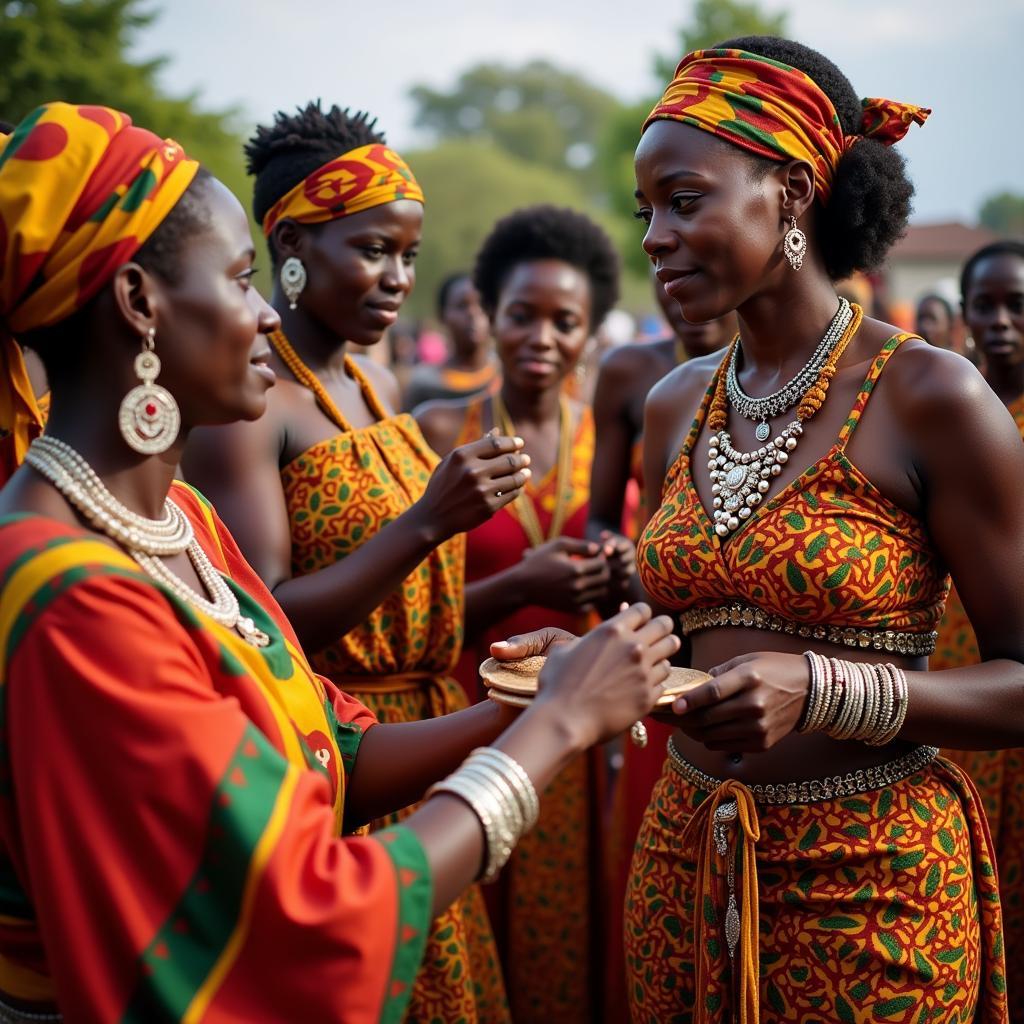African Clothing: A Vibrant Tapestry of Culture and Style
African clothing is a vibrant expression of the continent’s diverse cultures and rich history. More than just garments, these pieces tell stories of tradition, heritage, and artistry, passed down through generations and woven into the fabric of everyday life. From the bold patterns of West African Kente cloth to the intricate beadwork of the Maasai people, each region boasts unique styles and techniques that reflect its identity and beliefs.
Unveiling the Significance of African Clothing
African clothing transcends mere functionality, serving as a powerful language that communicates social status, marital standing, ethnicity, and even spiritual beliefs. The colors adorning a garment often hold deep symbolism – for instance, red might signify power and strength in one culture, while representing mourning in another. Similarly, intricate embroidery or beadwork can narrate ancestral tales or convey important messages.
“Clothing acts as a visual vocabulary in many African societies,” explains Dr. Abena Owusu, an anthropologist specializing in African textiles. “Every element, from the choice of fabric to the placement of embellishments, carries meaning and reflects the wearer’s place within their community.”
Exploring Regional Styles and Traditions
The African continent is a melting pot of over 50 countries, each boasting its unique fashion heritage. Let’s delve into some of the diverse regional styles:
West Africa: A Symphony of Colors and Patterns
West Africa is renowned for its vibrant textiles, often crafted from handwoven cotton or silk. The region is famous for its bold, geometric patterns and vibrant color palettes.
- Kente Cloth: Originating from Ghana, Kente cloth is a regal textile woven on narrow strip looms and sewn together. Each pattern and color combination carries specific meaning, often associated with proverbs, historical events, or social status.
- Adire Fabric: This indigo-dyed fabric from Nigeria is known for its resist-dyeing techniques, creating stunning patterns on cotton cloth. Adire comes in various styles, including Adire Eleko (using cassava paste) and Adire Oniko (tying raffia around fabric before dyeing).
East Africa: Elegance and Adornment
East African clothing reflects the region’s nomadic traditions and rich cultural influences. Beadwork, leatherwork, and flowing silhouettes are common elements.
- Kanga (Khanga): These rectangular pieces of cloth, often with Swahili proverbs printed on them, are ubiquitous in Tanzania and Kenya. Women typically wear two kangas, one around the waist and another draped over the shoulder.
- Maasai Shukas: The Maasai people of Kenya and Tanzania are recognized by their striking red shukas (blankets) wrapped around their bodies. The intricate beadwork adorning these garments signifies age, marital status, and social standing.
Southern Africa: A Fusion of Cultures
Southern African clothing reflects the region’s diverse ethnic groups and colonial history. Traditional garments often incorporate beadwork, animal skins, and natural materials.
- Shweshwe Fabric: Originally from Europe, this indigo-dyed cotton fabric has been adopted and reinterpreted in South Africa. Shweshwe is characterized by its distinct geometric patterns and is often used to make dresses, skirts, and shirts.
- Ndebele Beadwork: The Ndebele people of South Africa are renowned for their intricate beadwork, which adorns clothing, jewelry, and even their homes. The vibrant colors and geometric patterns hold cultural significance and tell stories about the wearer’s life and lineage.
The Evolution of African Clothing: From Tradition to Modernity
While traditional African clothing remains deeply significant, the continent’s fashion scene is constantly evolving. Today, African designers are gaining global recognition for their innovative designs that blend traditional aesthetics with contemporary styles.
From high-fashion runways to everyday streetwear, African prints and textiles are experiencing a surge in popularity worldwide. This global embrace reflects a growing appreciation for the beauty, cultural significance, and versatility of African clothing.
Conclusion
African clothing is a captivating journey through the continent’s diverse cultures, traditions, and artistic expressions. From the intricate beadwork of the Maasai to the bold patterns of Kente cloth, each garment tells a story and reflects the identity of its wearer. As African fashion continues to evolve and inspire the world, its enduring legacy lies in its ability to connect us to the rich tapestry of human creativity and cultural heritage.

